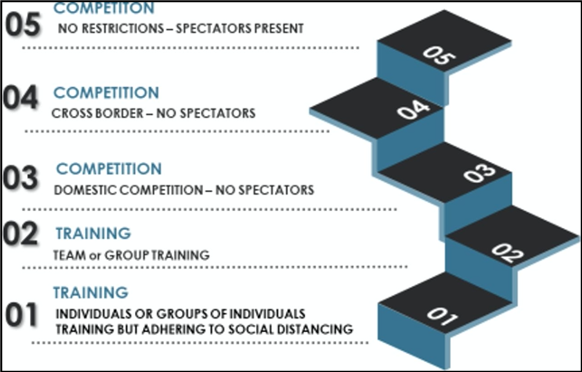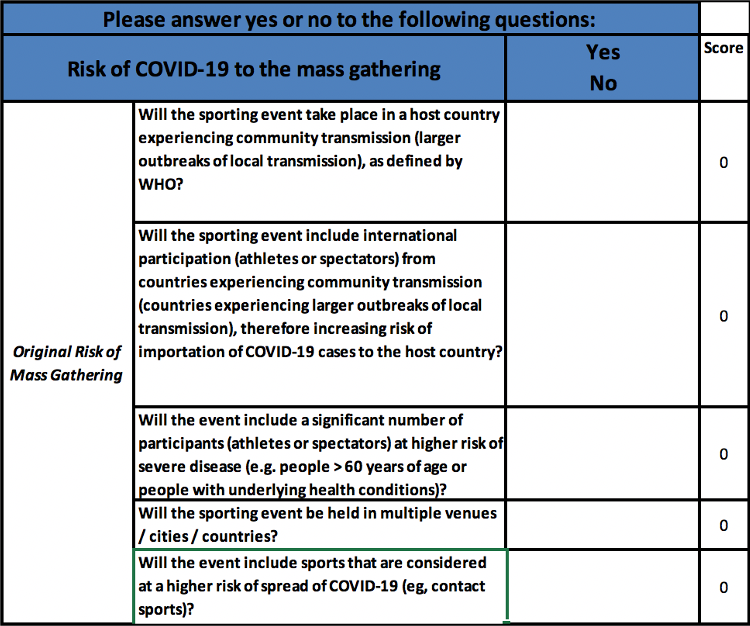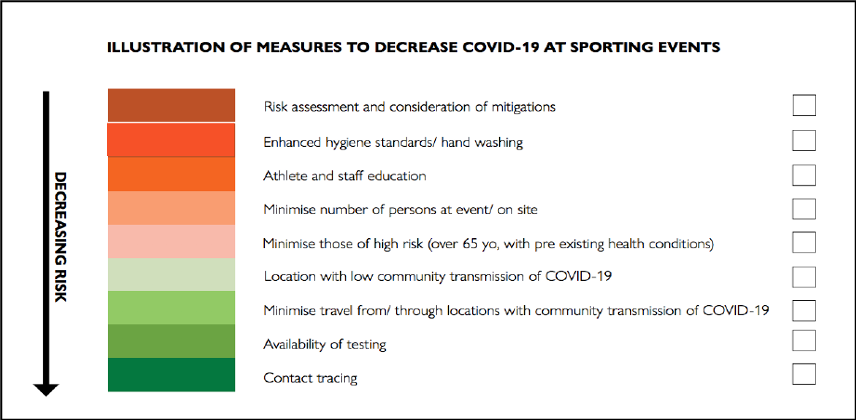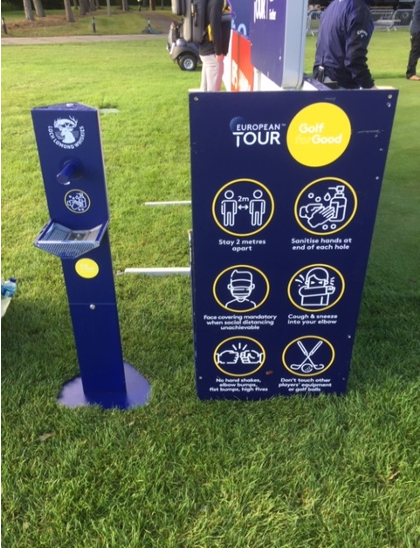How international golf has been safely recommenced during COVID-19: A week at The ISPS HANDA UK Championship
On 23rd March 2020 professional sport in the UK was effectively put on hold due to the COVID-19 pandemic. For elite sport to resume, a five-stage model was developed by sports medicine leaders (figure 1),1 which included stage-specific guidance from The Department for Digital, Culture, Media and Sport, working in close collaboration with Public Health England (PHE).2

Figure 1: Five-stage framework for the progression of UK sport.1
The past few months has seen the return of domestic and international sporting competitions with recent pilot events even re-introducing spectators. As per WHO recommendations, a risk assessment should be performed for all sporting events, with an emphasis on five key risk factors (figure 2).3-4 The overall risk of COVID-19 transmission can be further decreased through a series of mitigation measures (figure 3).5

Figure 2: Risk evaluation for a sporting event – adapted from WHO risk assessment tool.4

Figure 3: Series of mitigation measures that are recommended when event planning to reduce risk of COVID-19 transmission.5
Although golf is played outdoors and lends itself to social distancing, the robust and rigorous event planning conducted by The European Tour, allowed for its first international event to be held in Austria on the 9th-12th July. Since then, a total of 8 tournaments have been played including six as part of the UK swing culminating in the ISPS HANDA UK Championship at the Belfry on the 27th-30th August.
We were lucky enough to head to the Belfry under the supervision of Dr. Andrew Murray (Chief Medical Officer, European Tour) to witness how a major international golf tournament, which included 132 players from 5 different continents, could be successfully and safely run during the COVID-19 pandemic.
Pre-event
There is an emphasis on regular communication between sporting federations (e.g. FIFA and The ATP Tour) in order to share ideas and best practice. In the lead up to an event, there is close monitoring of the prevalence of COVID-19 within the local community, and regular discussions with the host government and local public health authorities as to whether the tournament can be held safely. Many proposed tournaments do not make the cut!
Education
All event attendees undergo a pre-tournament COVID-19 RT-PCR test in the days prior to arrival and are invited to start their accreditation process online. This includes a mandatory educational video covering mitigation measures that an individual can adhere to whilst onsite and is followed by an MCQ test requiring 80% to pass.

Inside the Tournament
Testing
Throughout the week Covid-19 officers are on hand to arrange testing for anyone new arriving onsite. On arrival every individual undertakes RT-PCR testing in a fully equipped mobile laboratory before gaining entry to the ‘inner bubble’. Once swabbed, a 2-4 hour wait for results ensues with clear instructions given to maintain social distancing and stay outside, or go to their hotel room during that time.
Buddy groups, social distancing and hand hygiene
Social distancing of >2m is enforced as standard, although a player and their caddy form their own buddy pairing within which closer proximity is permitted. Specific restaurant seating plans and one-way walking systems, in conjunction with holding meetings and media interviews outside, help to maintain the 2m rule and reduce risk of transmission. Masks are mandatory indoors, and there is an abundance of automatic hand sanitisers throughout the hotel and grounds. Cleaners are a regular and visible presence throughout. Medical consultations are conducted in PPE and limited to 15 minutes contact time.
Daily symptom and temperature check
Covid-19 symptoms and contact questions must be completed online each morning before an individual leaves their hotel room. Abnormal responses are followed up by the medical team. Everyone has a daily temperature check and receives a new wrist band to confirm a satisfactory result.
On the course
Hand sanitisers are available at every hole along with visible reminders of the safety measures to follow whilst playing: to not shake hands or fist bump, to stay 2m apart (golfer/caddy bubble not withstanding), and to not touch other players equipment.

Driving forward
As sport now looks to re-introduce spectators safely, The European Tour is looking at ways to innovate and progress. Proximity trackers were being trialled and new testing/screening methods researched.
We were able to observe planning meetings for future Tour events being held in a number of different countries, which naturally presents huge logistical challenges in the current climate. Collaboration with local Governments and Health Authorities in host countries is imperative in mitigating the risk of Covid-19.
Authors and Affiliations:
Jane Simpson1
Dionisio Izquierdo2
- Sport and Exercise Medicine registrar (ST5) currently working at The Institute of Sport, Exercise and Health, London. (Twitter: @DrJaneSimpson)
- Sport and Exercise Medicine registrar (ST4) currently working in Public Health at Barts Health NHS Trust, London. (Twitter: @DrDionisioIzq)
Acknowledgements:
We would sincerely like to thank the European Tour for their requesting registrars in Public Health and Sports and Exercise Medicine to attend, and feedback on processes. We thank Public Health England and Prof James Calder (Chair of the Return to Elite Sport Group) for facilitating this.
References:
- Kemp S, Cowie CM, Gillett M, Higgins R, Hill J, Iqbal Z, et al. Sports medicine leaders working with government and public health to plan a ‘return-to-sport’ during the COVID-19 pandemic: the UK’s collaborative five-stage model for elite sport. Br J Sports Med. 2020.
- The Department for Digital, Culture, Media and Sport. Coronavirus (COVID-19): guidance on the phased return of sport and recreation. https://www.gov.uk/government/publications/coronavirus-covid-19-guidance-on-phased-return-of-sport-and-recreation [Accessed 02 September 2020).
- WHO. Key planning recommendations for mass gatherings in the context of the current COVID-19 outbreak, 2020. Available: https://www.who.int/publications/i/item/10665-332235 [Accessed 02 September 2020].
- WHO mass gathering COVID-19 risk assessment tool – Sports events, 2020. Available: https://www.who.int/publications/i/item/10665-333187 [Accessed 02 September 2020].
- Carmody S, Murray A, Borodina M, Gouttebarge V, Massey A. When can professional sport recommence safely during the COVID-19 pandemic? Risk assessment and factors to consider. Br J Sports Med. 542020. p. 946-8.